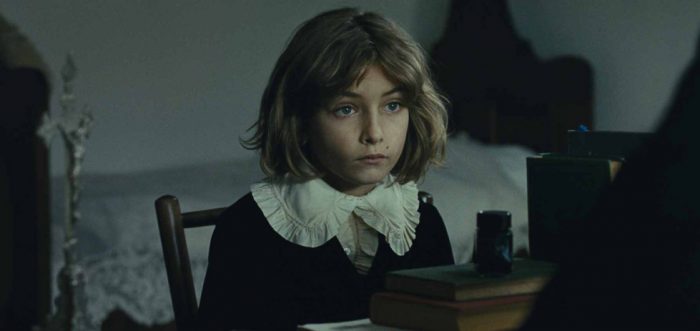
“Mother says we’re citizens of the world,” the sociopathic Little Lord Fauntelroy tells his French tutor. He’s right to be uncertain, what with a mother of French and German descent who speaks four languages, an American diplomat for a father, no clearly defined homeland for his youth and having to navigate his parents’ demands with discordantly crisp English articulation. This displacement of national identity runs to the heart of actor Brady Corbet’s directorial feature debut, The Childhood of a Leader; a dark fable that inflicts domestic echoes of WWI diplomacy upon a privileged family, and offers a parallel history just as terrifying as our own.
It’s late 1918 and an American diplomat (Liam Cunningham) working under Robert Lansing, Secretary of State to President Woodrow Wilson, moves his family to a manor in the French countryside so as to be closer to treaty negotiations in Versailles. We discover all this through whiskey-soaked conversations with free-agent political advisor Charles Marker (Robert Pattison) in the ornate, cigar-filled pool room of the house. The diplomat’s wife (Berenice Bejo) and seven-year-old son (Tom Sweet) are at a church service, young Prescott stumbling through half-learnt French in a rehearsal for the Christmas performance. Both are uneasy living here, not only because the diplomat treats them like chattel but also because of the pervasive sense of isolation — Prescott passes the time by toying with those around him, treating his French tutor (Stacy Martin) as a sexual object and being frustrated by his mother engaging only with the maids who dote on him.
Corbet moves us through Prescott’s acts of rebellion with bombastic chapter dividers, which prepare us for numbered “tantrums” through text. Something much darker is suggested through Scott Walker’s screeching, terrifying (and only rarely invoked) orchestral score. In terms of plotting, Corbet and co-writer Mona Fastvold aren’t particularly ambitious; while the film’s title is a nod to Jean Paul-Sartre’s short story of the same name, the pair draw more liberally from the childhood of Benito Mussolini, the most notable parallels being a bout of rock-throwing at parishioners, a rejection of religion and that particular haircut. The Childhood never comes out and suggests that the traits Prescott reveals are necessarily the stepping stones to dictatorship—after all, childhood rebellion is generally intrinsic to growing up. What it does do, though, is slowly burn through the simple plot beats while leaving a wealth of inferences in its wake. Prescott is as much a character as a symbol; proof of the failures inherent in the diplomatic successes of WWI and a product of an entrenched misogyny best wounded by public embarrassment. In its linking of childhood malice to historical horrors, the film is a less intricate but more immediate take on Michael Haneke’s The White Ribbon.1
Corbet’s swinging for the fences lands visually, moreso than ideologically, by pilfering from Kubrick and Visconti to interesting effect. Cinematographer Lol Crawley (who most recently worked on Andrew Haigh’s 45 Years) and Jean Vincent Puzos’ production design immediately calls to mind Barry Lyndon, which Childhood shares a 1.66:1 aspect ratio with. It similarly channels its focus on dimly-lit interior sequences; the first scene of dialogue in the film is gorgeously shot, as in Pattison and Cunningham are conjured up from the dark of the room in every set-up.
Whilst it’s great to see a lack of coverage in the film, with long-held shots and inventive framing being its best virtues, the ensemble staging is quite stiff early on, with the actors positioned as if in a badly directed stageplay, and with stilted timing. The film greatly improves on this midway through, not only visually but in terms of how it positions people in the sound mix. The poorly-mixed dialogue throughout moves from a flaw in the opening chapter (Cunningham and Pattison trade barbs that sounds slightly louder than a low hum) to an essential feature, wherein a late party scene becomes wonderfully disorienting when Corbet prioritises innocuous conversation over the dialogue of the principals.
The film’s finest moments come at its bookends. The opening credits, which begin on a black screen as an orchestra warms up, explode with hostility and tension through the mesh of Walker’s score and WWI-era newsreel footage, leading into contextless footage of train tracks as off-kilter text credits appear on screen. The final section, set decades after said childhood, is likely what the film will be remembered for. It’s the point where we move into historical fantasy, through a chilling implication that the world’s foremost dictator circa-1950 is not one emboldened by the damning effects of the Treaty of Versailles, but a party tangential to its creation. As Crawley’s camera gets scooped up by the masses eagerly awaiting Prescott’s arrival, Corbet’s heady mess of influences—literary, philosophical and formalist cinema—gives way to a visceral and discomforting command of tone. Moments like this are what makes The Childhood of a Leader such a fascinating debut feature film, marking Corbet as a filmmaker to watch.
Around the Staff:
| Jake Moody | |
| Luke Goodsell | |
| Virat Nehru | |
| Jaymes Durante | |
| Ian Barr |
